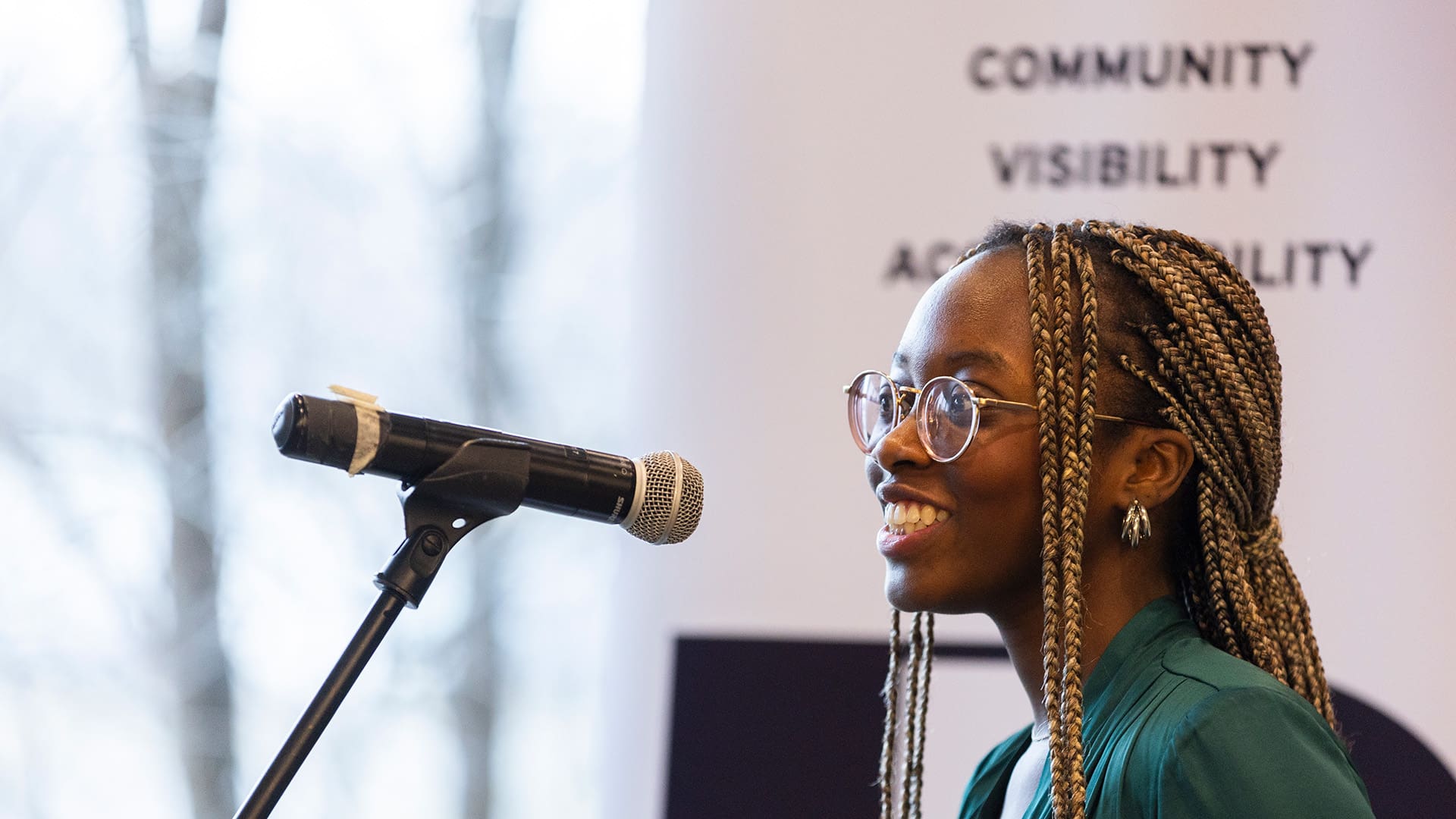Strategic Priorities

U of T Mississauga believes in a future better than the present, where Black staff, students, faculty, instructors, librarians, and caretakers thrive in a campus community that celebrates, cultivates, and learns from Black perspectives and expertise.
Since the summer of 2021, Black at UTM has gathered information about efforts our departments, units, and faculty are undertaking to enhance Black flourishing through calls for submissions and an environmental scan of current programs and services addressing anti-Black racism in 2022 and a second review in summer 2024. A series of consultations with Black community members, allies, and supporters about their experiences, expectations, and visions for progress were also held. These findings have been synthesized to develop a path forward for UTM through this Black Flourishing Framework.
The following sections outline our priorities, commitments, and ambitious plans to help shape UTM’s path over the next few years to cultivate Black flourishing and address anti-Black racism at UTM.
Within each area, the goal of each priority is described, including voices from UTM’s Black communities, and it also outlines accompanying commitments to serve as reference points to help us achieve our mission and vision and live our values. This framework capitalizes on our collective potential to make UTM a place for Black flourishing and inclusive excellence.

Elevate Black Expertise
 The Adinkrahene (pronounced “Ah-dink-rah-e-ne”) symbol emphasizes greatness, charisma, and leadership. It signifies the importance of Black-identifying individuals' leadership and influence at UTM.
The Adinkrahene (pronounced “Ah-dink-rah-e-ne”) symbol emphasizes greatness, charisma, and leadership. It signifies the importance of Black-identifying individuals' leadership and influence at UTM.Elevate Black Expertise
- Expand the Black Leadership Advisory Committee as a forum to improve equity policies, propose new anti-racist initiatives, and drive positive change.
- Amplify work by the Black Spaces and Belonging Committee, connecting its recommendations with other campus-wide space plans and processes.
- Engage Black students and employees intentionally on decision-making task forces and other major groups that shape the campus’ long-term direction.
Promote Accountability and Collective Responsibility
 The Ti Koro Nko Agyina (pronounced “Tee
The Ti Koro Nko Agyina (pronounced “Teekoh-roh n-koh ah-jee-nah”) symbol places
an emphasis on the value of collaboration
and working together to accomplish a
common objective. It draws attention to
the importance of people cooperating with
one another, recognizing that no single
person possesses all the answers or
solutions. It serves as a reminder that
having a wide variety of perspectives, skill
sets, and experiences is necessary to
achieve success.
Promote Accountability and Collective Responsibility
- Update, and share models from, the Black Inclusion and Excellence Dashboard annually to assess campus-specific progress on U of T’s fifty-eight commitments against anti-Black racism.
- Engage managers, directors, and senior leaders as champions and allies through events and partnership opportunities with the Black Initiatives Team.
- Extend Black at UTM’s presentation series, aiming to reach every team on campus to share priorities, discuss responsibilities, and identify opportunities for collaboration.
Enable Data-Informed Decisions
 The Ohene Aniwa (pronounced “Oh-heh-neh Ah-nee-wah”) symbol represents the “King's Eyes.” It symbolizes vigilance and farsightedness and the ability to perceive connections across all affairs at UTM in
The Ohene Aniwa (pronounced “Oh-heh-neh Ah-nee-wah”) symbol represents the “King's Eyes.” It symbolizes vigilance and farsightedness and the ability to perceive connections across all affairs at UTM inpromoting the conditions for Black flourishing.
Enable Data-Informed Decisions
- Leverage U of T’s employment equity survey to inform recruitment, retention, and professional development programs for Black faculty, staff, and librarians.
- Share results of U of T’s student equity census annually, including with academic departments to guide recruitment and retention plans.
- Promote broad access to and awareness of other campus-specific equity data to support gap analyses, shape strategic planning, and quantify credible successes.
Fund Initiatives Against Anti-Black Racism
 The Bese Saka (pronounced “Beh-seh Sah-kah”) represents cola nuts and has several meanings related to affluence, power, and abundance. It also signifies unity, emphasizing the importance of coming together as an institution to pull our collective resources towards a common cause.
The Bese Saka (pronounced “Beh-seh Sah-kah”) represents cola nuts and has several meanings related to affluence, power, and abundance. It also signifies unity, emphasizing the importance of coming together as an institution to pull our collective resources towards a common cause.Fund Initiatives Against Anti-Black Racism
- Establish new and sustain existing funding streams for pilot projects and events aligned with the fifty-eight recommendations of U of T’s Anti-Black Racism Task Force.
- Create, and fundraise for awards and scholarships to recognize the outstanding contributions of Black students, researchers, and employees.
- Continue to leverage and incentivize the use of U of T’s diversity in academic hiring funds and provost’s postdoctoral fellowship.
Build a Culture of Belonging
 The Nkonsonkonson (pronounced “En-kohn-son-kohn-son”) represents togetherness and community, and the power derives from each. It exemplifies the concept that our combined efforts make us more powerful and that, to achieve our objectives, we need to collaborate and live in peace with one another.
The Nkonsonkonson (pronounced “En-kohn-son-kohn-son”) represents togetherness and community, and the power derives from each. It exemplifies the concept that our combined efforts make us more powerful and that, to achieve our objectives, we need to collaborate and live in peace with one another.Build a Culture of Belonging
- Launch and resource sustainably, the new Centre for Black Excellence and Belonging as a designated campus space for community connection.
- Promote racially attuned approaches to Black mental health and wellness as grounded in Black communities’ values, histories, and lived experiences.
- Strengthen Black-centered campus, tri-campus, and alum networks to share best practices, make meaningful connections, and navigate U of T effectively.
Support Community Engagement and Dialogue
 This Sankofa (pronounced “Sahn-koh-fah”) is often associated with the proverb ”Se wo were fi na wosankofa a yenkyi,” which translates to ”It is not wrong to go back for that which you have forgotten.” This wisdom encourages us to reflect on history, embrace heritage, and use that knowledge to move forward positively.
This Sankofa (pronounced “Sahn-koh-fah”) is often associated with the proverb ”Se wo were fi na wosankofa a yenkyi,” which translates to ”It is not wrong to go back for that which you have forgotten.” This wisdom encourages us to reflect on history, embrace heritage, and use that knowledge to move forward positively.Support Community Engagement and Dialogue
- Expand opportunities for community building and intercultural understanding, extending momentum from Black on the Shelf, Inua Learning Circles, and other events in the Black at UTM series.
- Share anti-racist teaching and research resources, including workshops through the Teaching and Learning Collaborative and Black Research Network.
- Host the Black Flourishing and Inclusive Excellence Summit annually as a forum to share ideas, coordinate partnerships, and implement anti-racist priorities.
Increase Black Visibility and Impact
 The Abode Santann (pronounced ”Ah-bo-
The Abode Santann (pronounced ”Ah-bo-dah San-tann”) invites us to recognize the
interconnectedness of our collective
existence across UTM and appreciate our
institution’s natural and human-made
aspects.
Increase Black Visibility and Impact
- Create stories, campaigns, and other communications consistently, including profiles on the Black at UTM website, that celebrate Black excellence, experiences, and impact.
- Incorporate existing works by, and new commissions for, Black artists across campus spaces, as guided by our special advisor for public art.
- Develop leadership programs that support equitable career progression, including through secondments, special projects, and other opportunities for Black employees in roles beyond EDI.
Download PDF
